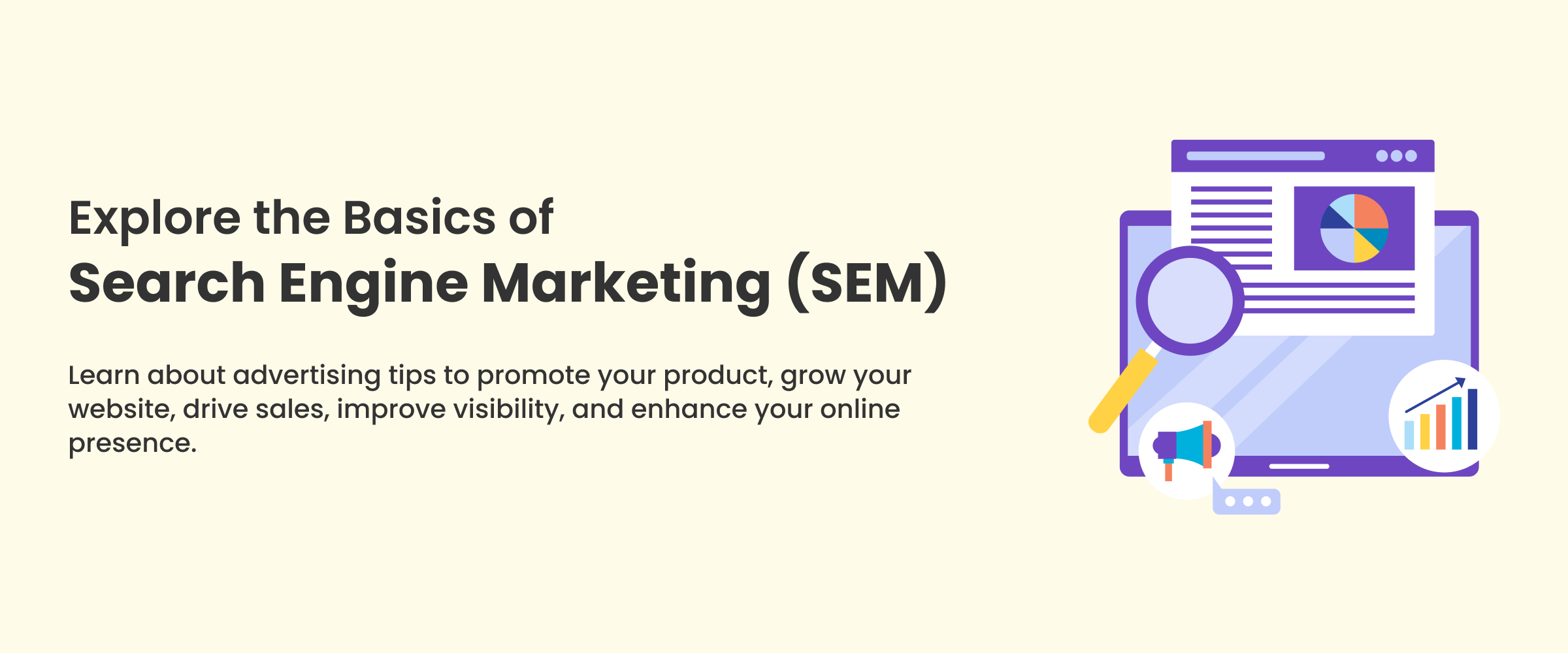What is Search Engine Marketing?: Benefits, Strategies, & More
Search Engine Marketing (SEM) is a powerful strategy to enhance companies’ online visibility and achieve remarkable success. By incorporating SEM, businesses can effectively amplify their presence on the web and attract a broader audience, ultimately leading to greater conversions and revenue generation. In this blog, we will explore the world of SEM, discuss its benefits, and provide insights on how to successfully implement an SEM strategy.
Understanding Search Engine Marketing
SEM is a broad term that includes a range of tactics aimed at improving the visibility of a website on search engine result pages (SERPs). For enhancing your knowledge of digital marketing, taking an online digital marketing course can be valuable.
It primarily includes methods such as:
1. Paid Search Advertising
Paid search advertising, also known as pay-per-click (PPC) advertising, is a highly effective and strategic approach for businesses. It serves as a powerful tool for capturing targeted website traffic and accomplishing various marketing goals and objectives.
The main objective of paid search advertising is to display prominent and eye-catching ads in prime locations on search engine result pages. These ads are strategically positioned above or beside the organic search results, ensuring high visibility and attracting user attention.
The charges for paid search advertising are incurred only when users engage with the ads by clicking on them. Marketers have consistently achieved remarkable success by implementing this methodical and consistent approach over time.
For example – To promote its specialized cake offerings, a neighborhood pastry shop uses paid search advertising on Google Ads. By placing bids on keywords like “custom cakes” and “birthday cakes”, their ads gain visibility whenever individuals search for these particular terms.
2. Search Engine Optimization (SEO)
SEO aims to enhance website visibility and organic search rankings where content optimization is a key element. Keyword research helps identify relevant search terms for targeting.
On-page optimization involves optimizing individual web pages for search engines. Technical enhancements focus on improving website performance and user experience. Link-building strategies aim to acquire high-quality backlinks from reputable websites. The primary goal of SEO is to attract organic traffic to a website.
For example – To enhance its digital presence effectively, a successful food blog places great importance on implementing SEO strategies. This encompasses carrying out extensive keyword research to discover highly sought-after phrases such as “simple vegetarian recipes”.
3. Remarketing
Remarketing concentrates on delivering targeted advertisements specifically tailored for individuals who recently browsed a company’s website or who didn’t complete desired actions (e.g., purchases, inquiry forms). This helps increase the probability of converting customers through personalized ads.
For example – An e-commerce store uses remarketing to enhance its advertising strategy. Through this method, the store can showcase advertisements with products previously viewed by users who did not complete a purchase.
Explore Internshala’s digital marketing course with placement for a better understanding of search engine marketing.
Working of SEM
Businesses use search engine marketing to rank their websites above the organic results in the search engine results pages. It helps increase revenue and reach new customers. But how does SEM help a website reach the top of SERP? Let us understand this by exploring the workings of search engine marketing.
- The process begins with an ad auction. You have to win an ad auction for your business website to rank at the top of search engine results pages. You are supposed to bid on keywords, conduct research, and then identify the keywords you wish to bid on. Choose a keyword relevant to your ad campaign and which is likely to convert.
- The next step is to decide how much you want to spend per click for each keyword. Remember, the price depends on your niche or industry. The average cost-per-click is higher for competitive industries than the less competitive ones. So, research and decide accordingly.
- Your ads will enter the auction once Google (or another program you use) determines that the keywords you bid on appear in the users’ search queries. If your ad has enough commercial intent, it will appear on searches. Otherwise, only organic results will be displayed.
If you consider Google Ads, some key factors influence your bidding at the ad auction. These are:
- Maximum bid or amount you are willing to pay per click on your ad.
- The quality score of your ad helps Google understand the ad’s relevance to the users.
- Your ad should meet the minimum quality threshold to rank higher. Here, ad rank, which is your bid and the quality of your ad and the landing page, is crucial.
- Ad context is another essential element. Google takes into account the search term, time of search, user’s location, devices they have used, etc.
- Additionally, the extra information, like links to other pages, contact details, etc., you provide in your ad also influences the result of the ad auction.
Once your ads appear on the search engine results pages, the users click on them and engage with your website accordingly. You pay the search engine provider every time a user clicks on your ad. Your return on investment should be higher than the total cost of pay-per-click (PPC) for your marketing campaign to be successful.
The Benefits of Search Engine Marketing
Search Engine Marketing (SEM) offers numerous advantages for businesses. These benefits include:
1. Increased Visibility and Brand Awareness
SEM enhances online visibility and facilitates the easy discovery of brands by customers. It helps reach higher levels of brand awareness and establish a strong presence in the digital landscape. It also drives business growth and contributes to attaining commendable success.
For example – A clothing brand that recently started up has made a strategic investment in search engine marketing to enhance its visibility and promote brand awareness. They have implemented targeted ad campaigns and used various SEO techniques.
2. Targeted Audience Reach
Search engine marketing (SEM) enables businesses to achieve the following:
- Effective keyword targeting.
- Precise demographic targeting.
- Reach potential customers actively searching for products/services.
- Enhance opportunities to connect with the right audience.
- Increase chances of driving conversions.
For example – A travel agency that specializes in adventure tours used SEM to target keywords, such as “hiking trips” and “adventure travel”. This strategic approach allows them to effectively cater their advertisements to users who are actively searching for these terms.
3. Cost-Effective Advertising
Search engine marketing offers companies cost-effective advertising solutions by controlling budgets and setting bid limits. Businesses only pay when users click on their ads. This way, advertising costs are directly tied to actual engagement. The CPC (cost-per-click) model provides a practical approach to maximizing return on investment (ROI) in marketing.
For example – Online shoe retailers are involved in setting a daily budget for their PPC campaign on Google Ads. They strategically bid on relevant keywords, such as “running shoes” and “athletic footwear” and only pay when customers click on their advertisements.
4. Measurable Results
Using SEM technology, organizations gain success by closely monitoring metrics like impressions, clicks, conversions, and ROI. Data-driven strategy allows continuous improvement and campaign fine-tuning. SEM also helps in the optimization of advertising expenditures.
For example – An e-commerce store utilizes analytics tools to track the performance of its SEM campaigns. They closely observe the impressions, click-through rates (CTR), and conversion rates for their targeted keywords.
Implementing a Successful Search Engine Marketing Strategy
The following are the methods by which you can implement a successful search engine marketing strategy.
1. Keyword Research and Selection
Keyword research is an integral part of creating an effective SEM strategy. It helps identify and select appropriate keywords. The goal is to find keywords with high search volume and low competition.
Google Keyword Planner is a valuable tool for conducting keyword research. Businesses can enhance their marketing campaigns and website content by using this tool.
For example – A digital marketing agency performs an extensive keyword analysis for a client in the real estate sector. To assist their client in reaching their target audience, they carefully pinpoint distinctive keywords associated with the purchase and sale of properties.


2. Ad Copy and Landing Page Optimization
Developing persuasive ad copy and optimizing landing pages are crucial for an effective SEM strategy. It includes the following:
- Captivating headlines
- Persuasive descriptions
- Impactful calls to action (CTAs)
It helps enhance campaign performance, improve user experience, and boost conversion rates. For example – A software company created an advertisement for their latest productivity application. In this ad, they highlighted the app’s notable features and advantages, enticing users to take advantage of a complimentary trial through compelling calls to action.
3. Monitoring and Analytics
Setting up tracking and analytical tools is essential for an effective SEM strategy. These tools help collect and report data related to your campaign. You can use this data to assess your campaign’s performance across multiple metrics like impressions, ROI, CTR, and CPC.
Some common tracking and analytics tools include the following:
- Google Ads
- Facebook Ads
- SEMrush
- Bing Ads
- Ahrefs
- HubSpot
Monitoring and analytics help you identify what is working for your campaign and what is not. You can optimize your ads, landing pages, keywords, and bids accordingly.
For example: A healthcare clinic diligently evaluates the effectiveness of its Search Engine Marketing (SEM) campaigns using Google Analytics. This entails a thorough examination of vital metrics, including click-through rates, conversion rates, and bounce rates.
Conclusion
Search engine marketing is a highly effective digital marketing strategy that brings about online success for businesses. By utilizing paid search advertising and search engine optimization, businesses can boost their visibility, connect with specific target audiences, and obtain results that are both efficient and budget-friendly. The implementation of a carefully devised SEM strategy allows businesses to tap into the immense potential of search engines and accomplish their objectives in the realm of online marketing.
What do you think is the most essential while developing a search engine marketing strategy for a business? Share your thoughts with us in the comments section below. To understand how search engine marketing differs from search engine optimization, check out this SEO vs SEM blog.
FAQs
In search engine marketing, your ads can appear in several places, including the search engine results page (SERP), typically at the top or bottom of organic search results. They may also appear on relevant websites within the display network, mobile apps, and YouTube videos. These ads can take the form of text ads, image-based banners, or video ads, targeting users based on keywords and interests for maximum visibility and engagement.
Search engine marketing can also be referred to as SEM or paid search advertising. It involves promoting a website or product through paid placements on search engine results pages. This method aims to increase visibility and drive targeted traffic by bidding on keywords relevant to the advertiser’s offerings.
When advertising using Search Engine Marketing (SEM), you only pay when a user clicks on your ad. This payment model is known as Pay-Per-Click (PPC). Advertisers bid on keywords, and their ads are displayed in search results; payment occurs only when a user interacts with the ad by clicking on it, directing them to the advertiser’s website.







